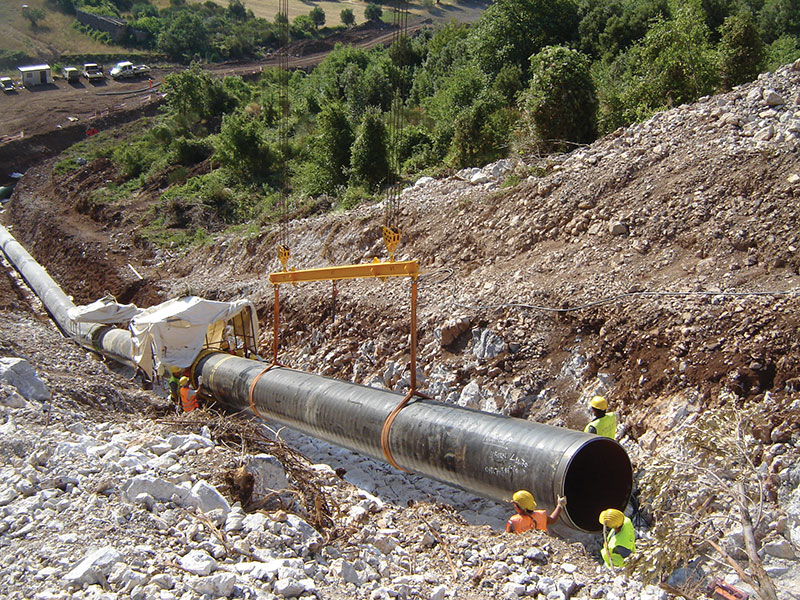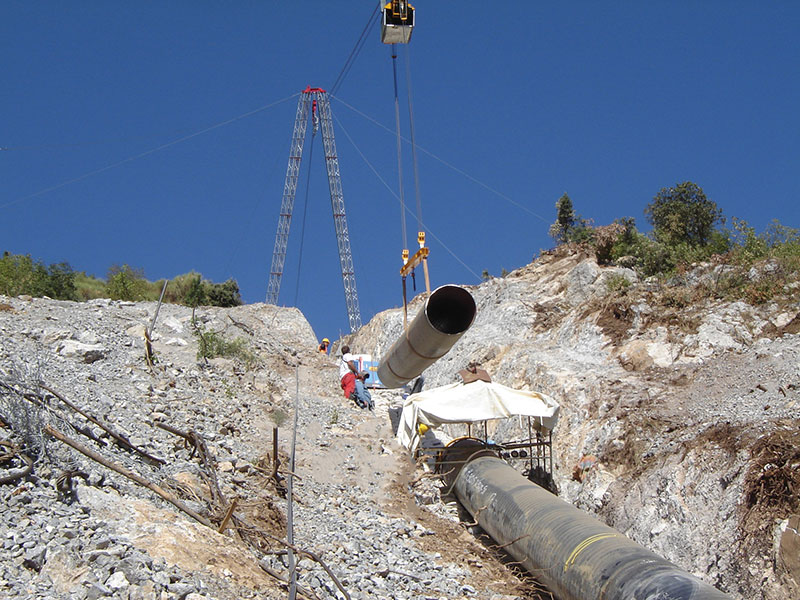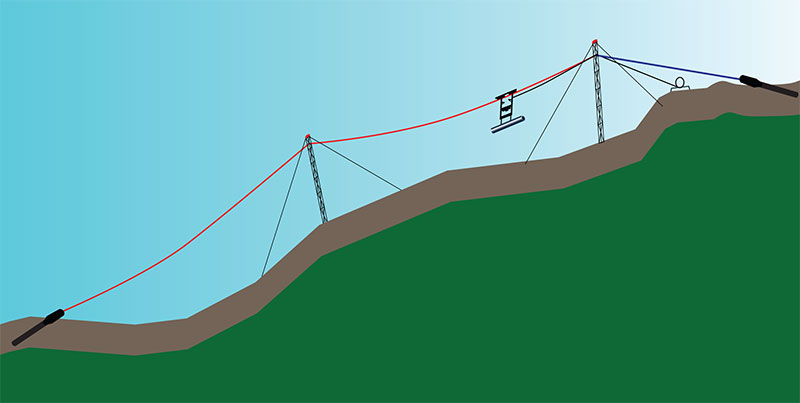July 2020, Vol. 247, No. 7
Features
Construction of Pipelines in Steep Terrain with Cable Crane Systems
By Joachim Seyr, LCS Cable Cranes GmbH, Austria
Cable crane systems provide the ideal solution when pipelines need to be built in inaccessible terrain. Pipes, construction material and equipment can be transported easily over demanding areas and can be positioned at any point of the track. With a maximum length of over 9,800 feet (3,000 meters) and a payload of up to 22 tons (20 metric tons), cable cranes can be operated in any type of steep terrain.
A cable crane system moves loads as it is suspended in mid-air over all kinds of terrain. The motorized crane unit can lift and lower loads at any point along the cable crane line. Furthermore, the crane unit consists of two separate lifting units, i.e., pipes can be positioned precisely in inclined areas and can be fitted easily into the welding clamp without any additional equipment.
With these systems, the impact on the environment can be kept as low as possible. Construction material and pipes can be transported to the designated point without any damage to natural habitats. Furthermore, the number of necessary roads can be reduced, and the route optimized, through direct positioning over the pipeline trench.
Cable cranes, with special adaptation, can also be used for manpower transportation to grant the personnel safe access to the job site at the slope. In such cases, a cabin is attached to the cable crane, which can be lowered and lifted at any position along the slope.
For safety purposes, cable cranes can also be used as an emergency rescue system to evacuate the manpower from the hill site or during an incident or accident along the track of the system.
Moreover, cable crane systems are independent of climatic conditions such as snow, fog, heavy rain, etc. Additionally, they can adapt perfectly to territorial challenges, for example, to overcome curves on the right-of-way (ROW) by using horizontal bend systems.
The first cable crane system ever used for pipeline construction in a steep section was a simple build “tower and cable construction” for the Trans-Alaska Pipeline in 1977. During one of the last phases, the team faced the 45-degree steep slope at Thompson Pass with a length of about 2,800 feet (850 meters). To lay the 48-inch (1,200-mm), 79-foot (24-meter) pipes, they used an easily built-up cable crane system.
Cable crane systems can transport single loads of up to 28 tons (25 metric tons) over 3,000 m. A line speed of these systems, of up to 20 feet per second (6 meters per second) can be achieved with a lifting speed of 4.9 feet per second (1.5 meters per second).
Cable Crane System
Cable crane systems generally consist of a hauling and a track rope, towers, anchors, crane units and winches for different demands. The machinery can be adapted to the payload, line speed and other special requirements to fulfill emission and safety standards.
The crane unit is winched up and down the slope by the haul rope and can lift and lower material at any point of the track. Furthermore, it is equipped with two motorized lifting devices that can be controlled simultaneously or separately by radio remote control. This allows the attached construction material to be moved into the desired position and inclination.
Installation
Temporary cable crane systems are built up by several modules, which are quickly available, and can be deployed promptly after a terrain analysis and the planning. The first step to assemble the system is to install the anchors and concrete foundations and the top and bottom stations. At the same time, the winch and winding device are positioned and horizontally, as well as vertically, secured.
Afterward, the towers are erected starting with the tower foundations with counter plates and finally lifted into the correct position. Depending on the terrain and length, the necessary number of towers are installed.
The next step is to spool the hauling rope onto the winch drum. The free end of the rope is pulled toward the bottom station while the rope is unspooled from the winch and everything is fixed. Subsequently, the track rope with its socket is attached to the anchors on both ends. Finally, the track rope is tensioned with a track rope tension set until the rope fits perfectly on the system; afterward, the crane unit is placed onto the track rope and connected with the haul rope.
Working Method
Construction of pipelines in steep sections with cable crane systems is a safe, efficient and environmentally friendly solution for transport in demanding areas, where traditional methods reach their limits.
Starting with the excavation of the trenches with special spider excavators, the cable crane system gets installed afterward, exactly along the centerline of the pipeline. The pipes are then attached to the slings and lifted with the crane unit.
Thereafter, they are transported to the intended location. Once the load arrives at the designated unloading point, it needs to be positioned accurately by the rigger in communication with the winch operator, adjusting the horizontal and vertical alignment.
Afterward, the pipe is lowered to the designated inclined position by operating the two lifting units of the crane unit independently. When the pipe is in its final location, it is fixed by welding clamps and the welding work is done. From a platform above the weld, sandblasting and coating works are carried out.
Furthermore, the cable crane system can place machinery and equipment outside of the trench by pulling sideways with chain hoists. The sideways movements depend on the relative height of the track rope vertically above the location in the trench. The maximum permitted deflection of the hoisting rope to the vertical is about 5 degrees. After the whole pipeline has been positioned, secured and welded, sandbags that are used as filling material and barriers can be transported with the cable crane system in a bulk or other container to the desired location and are unloaded.
Other filling material can also be moved from the loading points to the intended place where the operator unloads the goods by means of two independent lifting systems. After the pipeline has been laid, secured and covered with filling material, the system is dismantled. The dismantling is done in reverse order to the installation procedure.
System Advantages
The cable crane system is a suitable solution, especially in critical sections, for pipeline construction. Material with a payload of up to 20 metric tons can be loaded, transported and unloaded at any section of the system. This makes it possible to exactly position pipes in the intended place. Furthermore, the pipe can be held in place with the crane unit as long as necessary to position and weld it.
The systems are independent of climatic conditions. They can be used in the rainy season as well as during winter months, in the snow and with low temperatures. This significantly increases the time of use over the year compared to other transport solutions. The cable crane systems can be used in a temperature range from -4° F to 131° F (-20° C to 55° C).
Environmental Impact
Another advantage of a cable crane system is the low impact on the environment as opposed to the construction of roads, as their installation requires less intervention into nature. Steep and rocky terrain, rivers and lakes do not pose a problem. Due to the direct route above the pipeline, which can be followed, the system leaves a narrow ROW of only 20-26 feet (6-8 meters). After the completion of the construction work, it can be easily recultivated over time.
The construction of pipelines means handling heavy material, use of massive machinery and, consequently, a certain risk and need for safety standards. Cable crane systems significantly improve the safety standards in critical sections, because:
- no heavy machinery must access steep slopes;
- pipes, machinery and equipment are transported mid-air – directly to their final position.
- safe manpower transportation is possible with the use of a cable crane system;
- special securing winches are used for 100% safety.
- operators on the site are not exposed to risks, even though they are working in the most critical and challenging sectors.
Manpower Transportation
To allow the personnel to access any point of the slope during the pipeline construction for welding or other works, the cable crane system can be equipped with a gondola for limited manpower transportation. The personnel can get to any point of the track safely and comfortably, without additional access road construction.
In case a pipeline needs to follow a horizontal bend, or the terrain impedes the material ropeway to continue in a straight line, it is possible to install horizontal bend systems that allow the ropeway to adapt 100% to the terrain or desired track.
Cable crane systems increase the efficiency on pipe-laying in steep sections. This method can convert complex and challenging sections into very efficient pipeline constructions by:
- permitting direct routes over mountains and reducing the pipeline length in general;
- reducing re-instatement costs due to fewer pipeline kilometers; and
- avoiding additional road construction to gain access to steep areas.
Editor’s note: This paper was originally presented at the Pipeline & Technology Forum of 2019.








Comments